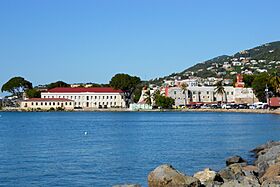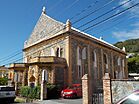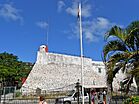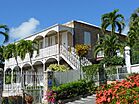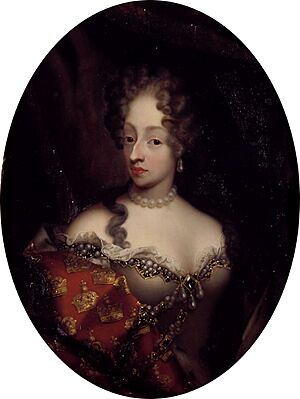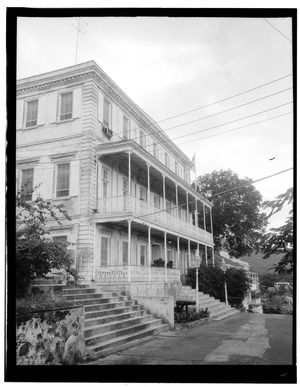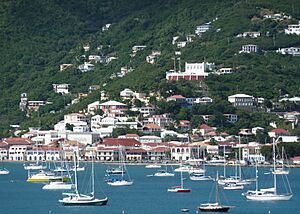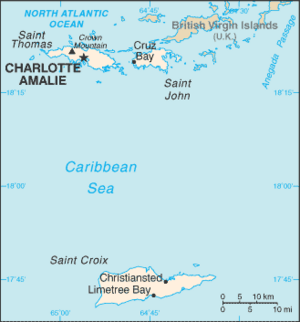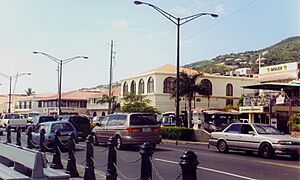Charlotte Amalie, U.S. Virgin Islands facts for kids
Quick facts for kids
Charlotte Amalie
|
|
|---|---|
|
Top: Skyline of Charlotte Amalie; Middle:Cathedral Church of All Saints, Fort Christian; Downtown Charlotte Amalie, Blackbeard's Castle
|
|
| Country | |
| Territory | |
| Area | |
| • Total | 3.14 km2 (1.213 sq mi) |
| Population
(2020)
|
|
| • Total | 14,477 |
| • Density | 4,608.1/km2 (11,935/sq mi) |
| Time zone | AST (UTC-4) |
| ZIP code(s) |
00801–00804
|
| Area code(s) | 340 |
Charlotte Amalie is the capital and largest city of the United States Virgin Islands. It is located on the island of St. Thomas. The city was founded in 1666 and was first called Taphus. This Danish word means 'tap house' or 'beer hall'. In 1691, the town was renamed Charlotte Amalie. This was done to honor the Danish queen Charlotte Amalie of Hesse-Kassel.
The city has a deep-water harbor. This harbor was once a safe place for pirates. Today, it is one of the busiest ports for cruise ships in the Caribbean. Over 1.5 million cruise ship passengers visit each year. The harbor is protected by Hassel Island. It has places for ships to dock, get fuel, and be repaired. It was even a U.S. submarine base until 1966.
People have lived in this area for many centuries. When Christopher Columbus arrived in 1493, native groups like the Caribs and Taíno lived there. Charlotte Amalie is on the southern shore of St. Thomas Harbor. In 2010, about 18,481 people lived there. This makes it the largest city in the Virgin Islands Archipelago. Many ferries and yachts pass through its waters every week.
Charlotte Amalie is famous for its Danish colonial buildings and history. Many streets and places still have Danish names. Important historical buildings include St. Thomas Synagogue, which is the second oldest synagogue in the United States, and Frederick Lutheran Church. The city also has many stories about pirates, especially Blackbeard (Edward Teach). Blackbeard's Castle and Bluebeard's Castle were built by the Danes in the 17th century. Blackbeard's Castle is a U.S. National Historic Landmark. Another popular spot is Fort Christian, the oldest building still standing in the Virgin Islands Archipelago.
Charlotte Amalie does not have its own local government. It is managed directly by the territorial government. However, the U.S. Census Bureau recognizes it as a town.
Contents
- Why is it Called Charlotte Amalie?
- What is the History of Charlotte Amalie?
- Where is Charlotte Amalie Located?
- Who Lives in Charlotte Amalie?
- What is the Economy Like?
- What is the Culture Like?
- Sports in Charlotte Amalie
- How Do People Get Around?
- Education in Charlotte Amalie
- Famous People from Charlotte Amalie
- Images for kids
- See also
Why is it Called Charlotte Amalie?
Before the time of the Danish West Indies (1754–1917), the city was known as Taphus. This name came from its many beer halls. Taphus is a Danish word that means 'beer house' or 'tap house'. In 1691, the town was given a more formal name. It was named Charlotte Amalie to honor the wife of Danish King Christian V, Charlotte Amalie of Hesse-Kassel.
Between 1921 and 1936, the United States called the city St. Thomas. But in 1936, it was officially recognized as Charlotte Amalie again.
What is the History of Charlotte Amalie?
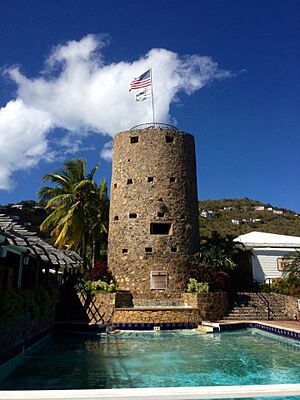
Early Days: Native People and Pirates
When Christopher Columbus visited the New World on his second trip, he met Native Americans living in the area. These islands are now the U.S. Virgin Islands. Old records show that groups like the Taíno, Arawak, and Kalinago/Carib lived there. Some of them lived in small fishing villages where Charlotte Amalie is today.
Like in many parts of the Americas, the native people quickly became sick and died after Europeans arrived. Spain focused on other islands, so St. Thomas was left open for a long time. This meant that pirates, like Blackbeard, often visited Charlotte Amalie's safe bays. Sailors and European settlers also came to the area.
Danish Rule and a Busy Port
The Danish West India Company started Charlotte Amalie in 1671. This was after King Christian V decided to claim the islands for plantations. In 1672, the Danish government began building Fort Christian in Charlotte Amalie. By 1675, they had built four pubs near the water.
The Danish government sent people who had committed crimes to work on the plantations. But they also allowed settlers from nearby islands to come. They also brought enslaved people from Africa. By 1680, there were more enslaved Black Africans than white European settlers. Nearby Water Island and Buck Island were used for grazing animals.
In 1691, Taphus was renamed Charlotte Amalie. It became the main port of the Virgin Islands Archipelago. One road connected it to about 50 plantations. This road is still the main highway today.
In the early 1700s, over 3,000 white settlers lived in the town. Growing sugar and trading enslaved people were the main ways people made money. In 1754, the Danish government wanted to control the islands directly. So, the capital was moved from Charlotte Amalie to Christiansted on St. Croix. This made Charlotte Amalie's economy change. It moved from trading enslaved people and farming to general trade.
Even with this change, the city kept growing. Merchants made money by trading weapons and rum to countries at war. In 1764, King Frederick V declared Charlotte Amalie a free port. This meant ships could trade there without paying taxes. The town became the busiest harbor in the Caribbean.
The American Revolution in the 1770s was good for businesses in Charlotte Amalie. Many immigrants from Europe, Africa, and other Caribbean islands came to the town. By 1778, the Danish government had built Bluebeard's Castle and Blackbeard's Castle. These were lookout towers on the hills near the city. The city grew rich as a free port. Many trading companies from different countries operated there.
By the end of the 1700s, Alexander Hamilton, who helped create the United States, said the town was so wealthy that "gold moved through the streets in wheel-barrows". At one point, Charlotte Amalie was the second-largest city in the Danish Realm, only smaller than Copenhagen.
Challenges and Changes
In the early 1800s, more trade in the West Indies passed through Charlotte Amalie. When steamships became popular, Charlotte Amalie was a perfect place for ships to stop for coal.
In 1804, a terrible fire destroyed over 1,200 homes and stores in the town. Two more fires in 1805 and 1806 destroyed another thousand buildings. Other islands started buying coal directly from producers. This meant Charlotte Amalie was less important for trade in the early 1800s. When slavery was ended in 1848, Charlotte Amalie's role in trade became even smaller. The town, like most of the Caribbean, faced a difficult economic time.
During the American Civil War in the early 1860s, the town became a center for smuggling goods. Ships used it to get around the federal blockade of ports in the Confederacy. Because of the port's success in smuggling, the Danish government moved the capital back to Charlotte Amalie in 1871. However, the late 1800s also brought a cholera sickness that killed thousands. Charlotte Amalie remained quiet until the United States bought the islands from Denmark in 1917.
Becoming Part of the U.S.
In 1915, the United States became interested in buying the U.S. Virgin Islands. They were worried about Germany's influence in the Lesser Antilles. The U.S. bought the Danish West Indies in 1917 for $25 million. Charlotte Amalie was under U.S. Navy rule until 1931. The United States decided to make Charlotte Amalie the main headquarters of the renamed United States Virgin Islands.
When American tourists could not visit Cuba in 1960, some started coming to Charlotte Amalie instead. The U.S. Virgin Islands became a popular place for U.S. citizens looking for luxury vacations or a second home. In the mid-20th century, resorts were built. More direct flights from the U.S. to Charlotte Amalie also helped tourism grow.
In the last half of the century, Charlotte Amalie's economy grew a lot. This was mainly because it was a U.S. territory with growing U.S. tourism. Tourism not only helped the economy but also led to the protection and repair of old buildings and homes. Many old commercial buildings became restaurants and shops. In the 1980s and 90s, many buildings were restored to look like they did 200 years ago.
The tourism industry has done very well on the island. It drives the economy of the U.S. Virgin Islands. However, there is not much flat land in the mountains. This limits how much Charlotte Amalie can grow. Building homes on hilltops overlooking the Caribbean waters also became popular in the 1960s.
Where is Charlotte Amalie Located?
Charlotte Amalie is on the south shore of the mountainous island of St. Thomas. It stretches about 1.5 miles around Saint Thomas Harbor. This goes from the Havensight area, where cruise ships dock, to Frenchtown in the west.
The red walls of the Danish Fort Christian and the open space of Emancipation Garden are in the center of the Old Town. Many of the city's old buildings and businesses are on the slopes of Government Hill. This area is called "Kongens Quarter." To the west, between Waterfront Drive and Dronningens Gade (Main Street), are many small streets. These are lined with old warehouse buildings that are now stores and malls.
Saint Thomas Harbor is a deep bay protected by Water Island and Hassel Island. You can see great views from lookout points as high as 1,500 feet, like Drake's Seat.
Charlotte Amalie is built on three low hills. These are called Frenchman Hill, Berg Hill, and Government Hill. The city is located at 18°21' north and 64°57' west.
What is the Climate Like?
Charlotte Amalie's average year-round temperatures are usually between 75 and 90°F (24 to 32°C). The climate is a tropical savanna climate (Köppen Aw). The city has a short dry season from January to March. The wet season covers the rest of the year. However, Charlotte Amalie usually does not get as much heavy rain as other tropical cities.
The city is generally very warm and humid. Average high temperatures are about 88°F (31°C). Average low temperatures are about 75°F (24°C).
| Climate data for Charlotte Amalie Airport (1991-2020 normals, extremes 1953–present) | |||||||||||||
|---|---|---|---|---|---|---|---|---|---|---|---|---|---|
| Month | Jan | Feb | Mar | Apr | May | Jun | Jul | Aug | Sep | Oct | Nov | Dec | Year |
| Record high °F (°C) | 93 (34) |
93 (34) |
94 (34) |
96 (36) |
97 (36) |
99 (37) |
98 (37) |
99 (37) |
98 (37) |
97 (36) |
95 (35) |
92 (33) |
99 (37) |
| Mean daily maximum °F (°C) | 84.1 (28.9) |
84.3 (29.1) |
84.5 (29.2) |
85.7 (29.8) |
87.2 (30.7) |
88.9 (31.6) |
89.7 (32.1) |
89.8 (32.1) |
89.2 (31.8) |
88.4 (31.3) |
86.6 (30.3) |
85.2 (29.6) |
87.0 (30.6) |
| Daily mean °F (°C) | 78.8 (26.0) |
78.9 (26.1) |
79.1 (26.2) |
80.6 (27.0) |
82.3 (27.9) |
84.1 (28.9) |
84.5 (29.2) |
84.7 (29.3) |
84.4 (29.1) |
83.3 (28.5) |
81.6 (27.6) |
80.1 (26.7) |
81.9 (27.7) |
| Mean daily minimum °F (°C) | 73.6 (23.1) |
73.5 (23.1) |
73.8 (23.2) |
75.5 (24.2) |
77.5 (25.3) |
79.3 (26.3) |
79.3 (26.3) |
79.6 (26.4) |
79.5 (26.4) |
78.3 (25.7) |
76.6 (24.8) |
74.9 (23.8) |
76.8 (24.9) |
| Record low °F (°C) | 63 (17) |
62 (17) |
60 (16) |
62 (17) |
66 (19) |
67 (19) |
66 (19) |
64 (18) |
64 (18) |
64 (18) |
61 (16) |
62 (17) |
60 (16) |
| Average rainfall inches (mm) | 2.64 (67) |
1.90 (48) |
1.86 (47) |
2.24 (57) |
3.02 (77) |
2.35 (60) |
2.91 (74) |
4.37 (111) |
5.89 (150) |
5.28 (134) |
6.06 (154) |
2.93 (74) |
41.45 (1,053) |
| Average rainy days (≥ 0.01 in) | 15.0 | 13.5 | 10.7 | 10.6 | 11.9 | 10.9 | 14.8 | 15.8 | 15.2 | 17.3 | 18.5 | 17.4 | 171.6 |
| Source: NOAA | |||||||||||||
Who Lives in Charlotte Amalie?
Demographics
The 2010 United States Census reported that Charlotte Amalie had a population of 18,481 people.
Most people (76.2%) are of Afro-Caribbean background. A smaller group (13.1%) are white. About one percent of the population is of Asian descent.
Religion
Most people (over 95%) in Charlotte Amalie are Christians. About 42% are Baptist, 34% are Catholic, and 17% are Episcopalian. There are also Jewish, Hindu, and Muslim communities.
The city's Saints Peter and Paul Cathedral is the main church for the Roman Catholic Diocese of Saint Thomas. This diocese covers the American Virgin Islands.
St. Thomas has one of the oldest Jewish communities in the Western Hemisphere. Sephardic Jews started settling on the island in the 1700s as traders. The St. Thomas Synagogue in Charlotte Amalie is the second oldest synagogue in the United States.
Languages Spoken
More than 95% of the people in Charlotte Amalie can read and write.
English is the official language. However, most people speak a local dialect called Virgin Islands Creole. This dialect is different from standard English. Virgin Islands Creole is used in everyday talks. Standard United States English (spoken with a unique Virgin Islands accent) is used more in school, at work, and in formal conversations. Most older children and adults can easily switch between Virgin Islands Creole and United States English.
About 16.8% of the city's people speak Spanish. This is often spoken by people from Puerto Rico and the Dominican Republic. About 6.6% speak French Patois. This is spoken by immigrants from places like St. Barthelemy and Haiti. Some people also speak Dutch and Papiamento. These are spoken by immigrants from Saba, Aruba, St. Maarten, and Curaçao.
What is the Economy Like?
The economy of Charlotte Amalie relies on tourism, handmade goods, jewelry, and making rum, bay rum, and jams. It is the political capital and the port capital of the U.S. Virgin Islands. Charlotte Amalie is the third most popular cruise ship destination in the Caribbean Sea. Up to eleven cruise ships can be in the harbor on a busy day. Usually, there are about five.
Tourism
About 1.5 million or more cruise ship passengers visit Charlotte Amalie each year.
Popular places for tourists include Blackbeard's Castle, Bluebeard's Castle, and the 17th-century Fort Christian. Other attractions are the Legislature Building, the 99 Steps Stairway, Emancipation Garden, Market Square, Seven Arches Museum, St. Thomas Synagogue, Frederick Lutheran Church, and the Weibel Museum.
Tourists usually arrive by plane at the Cyril E. King International Airport. This airport is about 2 miles west of downtown Charlotte Amalie. Or, they arrive by cruise ship at the port in Havensight. In recent years, Charlotte Amalie has benefited from being close to San Juan, Puerto Rico. Passengers from larger planes can fly to San Juan, then take a 30-minute flight to Charlotte Amalie. The city has also become a starting point for visiting other islands in the U.S. and British Virgin Islands. More high-speed ferries now leave Charlotte Amalie for St. Croix, St. John, and Tortola. A seaplane dock is near the west end of the inner harbor. These planes take passengers to St. Croix.
Because of its duty-free policies, the U.S. Virgin Islands are sometimes called "the duty-free capital of the world." Charlotte Amalie has more jewelry and perfume shops than anywhere else in the Caribbean. It is known for its outdoor shopping at Vendors' Plaza. On Main Street (Dronningens Gade), you can find many major stores.
Havensight and Crown Bay docks are other shopping areas. They have many stores next to the cruise ship docks. Along Dronningens Gade, there are over 400 shops, mostly selling jewelry. The western end, near Strand Gade, is called "Market Square." This was once the site of the biggest slave market auctions in the Caribbean Basin. Today, it is an open-air market where local farmers sell their produce.
What is the Culture Like?
The culture of Charlotte Amalie is a mix of American (U.S.) ways of life and Afro/Latino-Caribbean culture. It also has a strong influence from its Danish colonial history. You can find American fast food chains in the city. There are also local restaurants serving only Caribbean cuisine. Grocery stores have items from the U.S. mainland and local products like rum. You can find seafood and local produce at outdoor markets.
Danish Influence
Charlotte Amalie was named after the wife of Danish King Christian V. The Danish influence is still very strong today. You can see this heritage in many ways. The Danes left castles, cemeteries, churches, forts, town homes, sugar mills, and plantation houses that are still standing. Many places still have Danish names. Many local people also have Danish family roots.
The most common language, Virgin Islands Creole, has many words and phrases from the Danish language. For example, Danish words like "skål" (toast), "berg" (mountain), and "frikadeller" (meatballs) are often used. Much of the old colonial architecture is still there. Words like "street" are often called by the Danish word "gade."
Charlotte Amalie has the largest collection of colonial buildings in the Caribbean. Most of these buildings are classic Caribbean versions of English Georgian architecture. They were built by the Danes in the 1830s.
Sports in Charlotte Amalie
- C.A.H.S. Stadium is a sports venue in the city.
How Do People Get Around?
There are three main roads in Charlotte Amalie. Waterfront Drive, also called Veteran's Drive, runs along the harbor. It goes from Havensight Mall to Frenchtown. This four-lane road is best for cars or taxis. Main Street, also called Dronningen's Gade and Norre Gade, runs next to the waterfront. Back Street, also called Wimmelskafts Gade, is one block further inland. The street names in the town are reminders of the island's Danish past.
Charlotte Amalie is special because it is the only U.S. capital city (of a territory or state) where traffic drives on the left side of the road. This is even though the U.S. drives on the right. After trying to switch to the right side for 14 years, people wanted to go back to driving on the left. So, they did! The U.S. Virgin Islands (USVI) is the only U.S. place where people drive on the left. However, almost all cars have the steering wheel on the left side. This is because most cars are imported from the U.S.
Highway 30 (Veterans Drive) goes through Charlotte Amalie. The city also has one of the two airports in the U.S. Virgin Islands. Cyril E. King Airport (IATA: STT ICAO: TIST) has regular direct flights to cities like Atlanta, Chicago, and other places on the east coast of the United States.
Education in Charlotte Amalie
The St. Thomas-St. John School District serves the community. Addelita Cancryn Junior High School and Charlotte Amalie High School are schools in the area. The University of the Virgin Islands, located in Charlotte Amalie, was started in 1962.
Famous People from Charlotte Amalie

- Alton Adams – He wrote the lyrics for the Virgin Islands National Anthem. He was also the first African-American bandmaster in the United States Navy.
- Edward Wilmot Blyden – An ambassador who helped start the idea of West African nationalism.
- Callix Crabbe – A Major League Baseball player.
- Hannah Davis – A fashion model.
- Kelsey Grammer – An actor, director, and producer.
- Emile Griffith – A boxer who won world championships.
- Alexander Hamilton – Born on the nearby island of Nevis. He grew up in the Danish West Indies (now the U.S. Virgin Islands).
- Elrod Hendricks – A Major League Baseball player.
- Julian Jackson – A boxer.
- J. Raymond Jones – A political activist.
- Al McBean – A Major League Baseball player.
- Alonzo G. Morón (1909–1971) – A university president, educator, and civil servant. He was born in Charlotte Amalie.
- Ralph Moses Paiewonsky – A governor.
- Calvin Pickering – A Major League Baseball player.
- Charles Sainte-Claire Deville – A French geologist.
- Henri Sainte-Claire Deville – A French chemist.
- Camille Pissarro – A key member of the French Impressionist painters.
- Rashawn Ross – A trumpeter who tours with Dave Matthews Band.
- Roy Lester Schneider – A governor and physician.
- Morris Simmonds – A German physician and pathologist.
- Karrine Steffans – A New York Times best-selling author.
- Terence Todman – An ambassador.
- Denmark Vesey – A leader of a planned slave uprising in Charleston, South Carolina.
- Peter von Scholten – A governor general.
- David Levy Yulee – The first Jewish member of the United States Senate.
Images for kids
See also
 In Spanish: Charlotte Amalie para niños
In Spanish: Charlotte Amalie para niños


